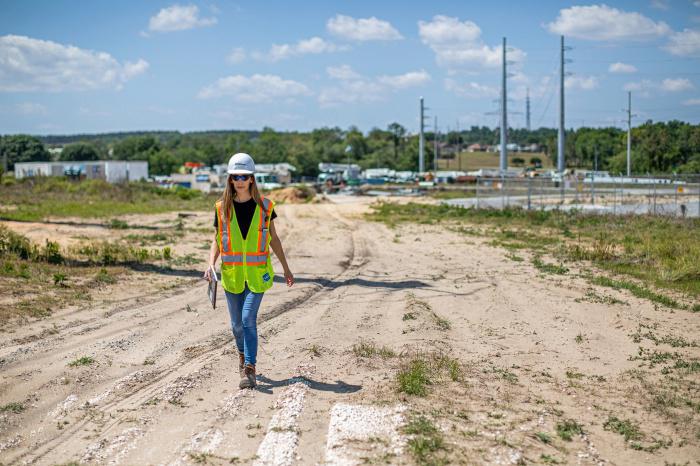Energy Burns & McDonnell Navigates Passage Between Electric Revolution And Supply Chain Crisis Llewellyn King Contributor Opinions expressed by Forbes Contributors are their own. I’ve been a player in energy since founding The Energy Daily in 1973. New! Follow this author to improve your content experience.
Got it! Jun 20, 2022, 10:07pm EDT | Share to Facebook Share to Twitter Share to Linkedin She keeps a close watch on a transmission line. Burns & McDonnell The electric power industry is going through the greatest revolution since its founding by Thomas Edison, Nicola Tesla, George Westinghouse, and other pioneers. It is a revolution that reaches into every aspect of utility operation, from the preeminence of data to the shift from coal and natural gas generation to wind and solar.
The changes are monumental and yet they are happening in an industry that is fundamentally conservative and risk-averse. To understand the dynamics at work, I conducted a virtual interview with three hands-on engineers from Burns & McDonnell , the Kansas City, Missouri-based engineering, construction and architecture firm whose customers are spread across the utility landscape, from rural co-ops to municipally owned utilities to giant, investor-owned companies. Burns & McDonnell is employee owned and has a complement of over 10,000 engineers, construction and craft professionals working from Scotland to San Diego.
It offers a full range of services besides electric utility work. It designs and builds bridges, refineries, communications networks, and helps with military installations. Talking to the engineers is akin to talking to medical personnel rather than patients.
They are there for the long-term planning as well as for the immediate crisis that shakes a utility’s ability to keep the lights on. Meghan Calabro is in the thick of it, you might say. As managing director of distribution modernization at Burns & McDonnell, she leads a team of 225 engineers and designers spread across many projects.
MORE FOR YOU Here’s The List Of 317 Wind Energy Rejections The Sierra Club Doesn’t Want You To See Revisiting The Blame For High Gas Prices Why Do ‘Fracking’ Opponents Ignore Its Moral Benefits? Internal And External Forces Calabro understands the internal and external forces at work in utilities. “The challenge is balancing the immediate, real-time needs with each utility’s long-term capital investment plan. ” For example, she said, “We had a tornado touch down in Kansas City recently.
Now, you know, they are going out and doing everything to get power back on, like replacing poles and restoring conductors. ” To Calabro, the biggest challenge for utilities is the tug between the real-time needs of the present and their “big-picture dreams of making them bigger, better, stronger, smarter. ” Meeting that challenge is compounded at present by near-crippling supply chain shortages .
Matt Olson, managing director of the telecoms group at Burns & McDonnell, said those shortages are serious and getting worse. Utilities can assemble crews, but they are useless unless they can be equipped, he said. Shortages extend all the way from such commonplace things as bolts, to trucks and lifts.
“We are quoted 47 months to get a new lift for a utility truck,” Olson said. Scheduling crews productively is a big headache because of the shortages, he said. These could be Burns & McDonnell crews, contractors’ crews, or crews provided by the host utility.
But whoever’s crews they may be, they must be assigned. Once made well in advance, assignments are now being made by the half-day because of shortages, making it hard to organize productive work. Shortage Of Personnel The other great challenge the utilities face is a shortage of personnel.
“In addition to the materials shortages, is the vital human resource shortage,” Olson said, adding, “Every utility is facing this crisis, from the linemen to the engineers needed to manage and design the changes the utilities need to make. ” The great utility revolution is crying out for people to man it and see it through. Burns & McDonnell has a consulting business under the name 1898 & Co.
—a nod to the company’s founding at the end of the 19 th century. Lucas McIntosh, a managing director, sees the consulting function as one of looking forward. “The best word for what we do is ‘planning.
’ ” This can vary from the large movements that utilities face in the future to their immediate needs. Speaking about utility planning, McIntosh said, “Crews are very good at fixing what is broken. Much of the work at utilities nowadays is balancing work and resources while trying to bring about change.
” The object is to move projects forward not by repairing things to old standards, but rather by getting change implemented as things move forward. McIntosh explained, “It takes the involvement of engineering and design and planning and scheduling to prepare the teams. This means new equipment and goals to implement new standards and designs, so that we make progress towards modernization in our daily work rather than recommit to old design standards.
” The Burns & McDonnell engineers, each in their own way, pointed to the struggle with the inertia of the old and the demands of the new. The C-Suite may order the new and the revolutionary, but the inertia of the past, the temptation of the old because it worked, is a powerful force in the workplace. Unlike retooling a factory, Calabro pointed out, “a utility can’t shut down for several months while the whole plant is redesigned and retooled.
The lights have to stay on. ” Nonetheless, she said, there is no more exciting place to be than in a utility when there has been an interruption in supply. Everyone focuses their energy and drives for one goal: Getting the lights back on.
Heady, important stuff. Llewellyn King Editorial Standards Print Reprints & Permissions.
From: forbes
URL: https://www.forbes.com/sites/llewellynking/2022/06/20/burns–mcdonnell-navigates-passage-between-electric-revolution-and-supply-chain-crisis/
